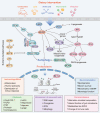Dietary regulation in health and disease
- PMID: 35871218
- PMCID: PMC9308782
- DOI: 10.1038/s41392-022-01104-w
Dietary regulation in health and disease
Abstract
Nutriments have been deemed to impact all physiopathologic processes. Recent evidences in molecular medicine and clinical trials have demonstrated that adequate nutrition treatments are the golden criterion for extending healthspan and delaying ageing in various species such as yeast, drosophila, rodent, primate and human. It emerges to develop the precision-nutrition therapeutics to slow age-related biological processes and treat diverse diseases. However, the nutritive advantages frequently diversify among individuals as well as organs and tissues, which brings challenges in this field. In this review, we summarize the different forms of dietary interventions extensively prescribed for healthspan improvement and disease treatment in pre-clinical or clinical. We discuss the nutrient-mediated mechanisms including metabolic regulators, nutritive metabolism pathways, epigenetic mechanisms and circadian clocks. Comparably, we describe diet-responsive effectors by which dietary interventions influence the endocrinic, immunological, microbial and neural states responsible for improving health and preventing multiple diseases in humans. Furthermore, we expatiate diverse patterns of dietotheroapies, including different fasting, calorie-restricted diet, ketogenic diet, high-fibre diet, plants-based diet, protein restriction diet or diet with specific reduction in amino acids or microelements, potentially affecting the health and morbid states. Altogether, we emphasize the profound nutritional therapy, and highlight the crosstalk among explored mechanisms and critical factors to develop individualized therapeutic approaches and predictors.
© 2022. The Author(s).
Conflict of interest statement
The authors declare no competing interests.
Figures



Similar articles
-
Nutrition and dietary restrictions in cancer prevention.Biochim Biophys Acta Rev Cancer. 2024 Jan;1879(1):189063. doi: 10.1016/j.bbcan.2023.189063. Epub 2023 Dec 24. Biochim Biophys Acta Rev Cancer. 2024. PMID: 38147966 Review.
-
Regulation of metabolic health and aging by nutrient-sensitive signaling pathways.Mol Cell Endocrinol. 2017 Nov 5;455:13-22. doi: 10.1016/j.mce.2016.11.014. Epub 2016 Nov 22. Mol Cell Endocrinol. 2017. PMID: 27884780 Free PMC article. Review.
-
Molecular mechanisms of dietary restriction promoting health and longevity.Nat Rev Mol Cell Biol. 2022 Jan;23(1):56-73. doi: 10.1038/s41580-021-00411-4. Epub 2021 Sep 13. Nat Rev Mol Cell Biol. 2022. PMID: 34518687 Free PMC article. Review.
-
Dietary interventions and precision nutrition in cancer therapy.Trends Mol Med. 2023 Jul;29(7):489-511. doi: 10.1016/j.molmed.2023.04.004. Epub 2023 May 30. Trends Mol Med. 2023. PMID: 37263858 Review.
-
Dietary Restriction and Nutrient Balance in Aging.Oxid Med Cell Longev. 2016;2016:4010357. doi: 10.1155/2016/4010357. Epub 2015 Nov 23. Oxid Med Cell Longev. 2016. PMID: 26682004 Free PMC article. Review.
Cited by
-
Design, synthesis, in vitro and in vivo biological evaluation of pterostilbene derivatives for anti-inflammation therapy.J Enzyme Inhib Med Chem. 2024 Dec;39(1):2315227. doi: 10.1080/14756366.2024.2315227. Epub 2024 Feb 29. J Enzyme Inhib Med Chem. 2024. PMID: 38421003 Free PMC article.
-
Biomarkers of Micronutrients and Phytonutrients and Their Application in Epidemiological Studies.Nutrients. 2023 Feb 15;15(4):970. doi: 10.3390/nu15040970. Nutrients. 2023. PMID: 36839326 Free PMC article. Review.
-
Influence of Microbiota on Tumor Immunotherapy.Int J Biol Sci. 2024 Mar 31;20(6):2264-2294. doi: 10.7150/ijbs.91771. eCollection 2024. Int J Biol Sci. 2024. PMID: 38617537 Free PMC article. Review.
-
The Epithelial to Mesenchymal Transition in Colorectal Cancer Progression: The Emerging Role of Succinate Dehydrogenase Alterations and Succinate Accumulation.Biomedicines. 2023 May 11;11(5):1428. doi: 10.3390/biomedicines11051428. Biomedicines. 2023. PMID: 37239099 Free PMC article. Review.
-
Metabolic regulation of innate immunity in cancer immunotherapy.Cancer Biol Med. 2024 Feb 5;20(12):898-902. doi: 10.20892/j.issn.2095-3941.2024.0022. Cancer Biol Med. 2024. PMID: 38318816 Free PMC article. No abstract available.
References
Publication types
MeSH terms
LinkOut - more resources
Full Text Sources
Molecular Biology Databases

